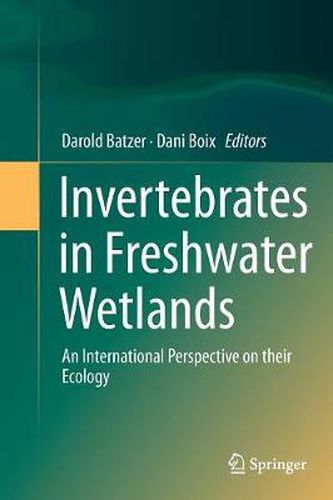Readings Newsletter
Become a Readings Member to make your shopping experience even easier.
Sign in or sign up for free!
You’re not far away from qualifying for FREE standard shipping within Australia
You’ve qualified for FREE standard shipping within Australia
The cart is loading…






This title is printed to order. This book may have been self-published. If so, we cannot guarantee the quality of the content. In the main most books will have gone through the editing process however some may not. We therefore suggest that you be aware of this before ordering this book. If in doubt check either the author or publisher’s details as we are unable to accept any returns unless they are faulty. Please contact us if you have any questions.
Wetlands are among the world’s most valuable and most threatened habitats, and in these crucially important ecosystems, the invertebrate fauna holds a focal position. Most of the biological diversity in wetlands is found within resident invertebrate assemblages, and those invertebrates are the primary trophic link between lower plants and higher vertebrates (e.g. amphibians, fish, and birds). As such, most scientists, managers, consultants, and students who work in the world’s wetlands should become better informed about the invertebrate components in their habitats of interest. Our book serves to fill this need by assembling the world’s most prominent ecologists working on freshwater wetland invertebrates, and having them provide authoritative perspectives on each the world’s most important freshwater wetland types. The initial chapter of the book provides a primer on freshwater wetland invertebrates, including how they are uniquely adapted for life in wetland environments and how they contribute to important ecological functions in wetland ecosystems. The next 15 chapters deal with invertebrates in the major wetlands across the globe (rock pools, alpine ponds, temperate temporary ponds, Mediterranean temporary ponds, turloughs, peatlands, permanent marshes, Great Lakes marshes, Everglades, springs, beaver ponds, temperate floodplains, neotropical floodplains, created wetlands, waterfowl marshes), each chapter written by groups of prominent scientists intimately knowledgeable about the individual wetland types. Each chapter reviews the relevant literature, provides a synthesis of the most important ecological controls on the resident invertebrate fauna, and highlights important conservation concerns. The final chapter synthesizes the 15 habitat-based chapters, providing a macroscopic perspective on natural variation of invertebrate assemblage structure across the world’s wetlands and a paradigm for understanding how global variation and environmental factors shape wetland invertebrate communities.
$9.00 standard shipping within Australia
FREE standard shipping within Australia for orders over $100.00
Express & International shipping calculated at checkout
This title is printed to order. This book may have been self-published. If so, we cannot guarantee the quality of the content. In the main most books will have gone through the editing process however some may not. We therefore suggest that you be aware of this before ordering this book. If in doubt check either the author or publisher’s details as we are unable to accept any returns unless they are faulty. Please contact us if you have any questions.
Wetlands are among the world’s most valuable and most threatened habitats, and in these crucially important ecosystems, the invertebrate fauna holds a focal position. Most of the biological diversity in wetlands is found within resident invertebrate assemblages, and those invertebrates are the primary trophic link between lower plants and higher vertebrates (e.g. amphibians, fish, and birds). As such, most scientists, managers, consultants, and students who work in the world’s wetlands should become better informed about the invertebrate components in their habitats of interest. Our book serves to fill this need by assembling the world’s most prominent ecologists working on freshwater wetland invertebrates, and having them provide authoritative perspectives on each the world’s most important freshwater wetland types. The initial chapter of the book provides a primer on freshwater wetland invertebrates, including how they are uniquely adapted for life in wetland environments and how they contribute to important ecological functions in wetland ecosystems. The next 15 chapters deal with invertebrates in the major wetlands across the globe (rock pools, alpine ponds, temperate temporary ponds, Mediterranean temporary ponds, turloughs, peatlands, permanent marshes, Great Lakes marshes, Everglades, springs, beaver ponds, temperate floodplains, neotropical floodplains, created wetlands, waterfowl marshes), each chapter written by groups of prominent scientists intimately knowledgeable about the individual wetland types. Each chapter reviews the relevant literature, provides a synthesis of the most important ecological controls on the resident invertebrate fauna, and highlights important conservation concerns. The final chapter synthesizes the 15 habitat-based chapters, providing a macroscopic perspective on natural variation of invertebrate assemblage structure across the world’s wetlands and a paradigm for understanding how global variation and environmental factors shape wetland invertebrate communities.